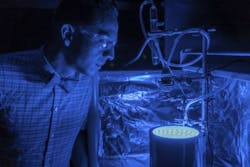Visible-light photoreactor uses photosynthesis to convert CO2 to clean air and fuel
University of Central Florida (UCF; Orlando, FL) chemistry professor Fernando Uribe-Romo and his students have found a way to trigger the process of photosynthesis in a synthetic material, turning greenhouse gases into clean air and producing energy all at the same time. The process details, published in the Journal of Materials Chemistry A, have great potential to significantly reduce greenhouse gases linked to climate change, while also creating a clean way to produce energy.
RELATED ARTICLE: Light-capturing nanowires reduce carbon dioxide into useful chemicals and fuels
"This work is a breakthrough," said Uribe-Romo. "Tailoring materials that will absorb a specific color of light is very difficult from the scientific point of view, but from the societal point of view we are contributing to the development of a technology that can help reduce greenhouse gases." The chemical reaction is triggered in a synthetic material called metal-organic frameworks (MOFs) that breaks down carbon dioxide into harmless organic materials--an artificial photosynthesis process similar to the way plants convert carbon dioxide (CO2) and sunlight into food. But instead of producing food, Uribe-Romo's method produces solar fuel.
It's something scientists around the world have been pursuing for years, but the challenge is finding a way for visible light to trigger the chemical transformation. Ultraviolet rays have enough energy to allow the reaction in common materials such as titanium dioxide, but UVs make up only about 4% of the light Earth receives from the sun. The visible range represents the majority of the sun's rays, but there are few materials (and many of them are rare and expensive such as platinum, rhenium, and iridium) that pick up these light colors to create the chemical reaction that transforms CO2 into fuel.
Uribe-Romo used titanium--a common nontoxic metal--and added organic molecules that act as light-harvesting antennae to see if that configuration would work. The light harvesting antenna molecules, called N-alkyl-2-aminoterephthalates, can be designed to absorb specific colors of light when incorporated in the MOF. In this case he synchronized it for the color blue.
His team assembled a blue LED photoreactor to test out the hypothesis using strips of LED lights to mimic the sun's blue wavelength. Measured amounts of CO2 were slowly fed into the photoreactor--a glowing blue cylinder that looks like a tanning bed--to see if the reaction would occur. It worked and the chemical reaction transformed the CO2 into two reduced forms of carbon: formate and formamides (two kinds of solar fuel) and in the process cleaning the air.
"The goal is to continue to fine-tune the approach so we can create greater amounts of reduced carbon so it is more efficient," Uribe-Romo said. He wants to see if the other wavelengths of visible light may also trigger the reaction with adjustments to the synthetic material. If it works, the process could be a significant way to help reduce greenhouse gases. "The idea would be to set up stations that capture large amounts of CO2, like next to a power plant. The gas would be sucked into the station, go through the process and recycle the greenhouse gases while producing energy that would be put back into the power plant."
Other members of the team who worked on the paper include UCF graduate student Matt Logan, who is pursuing a Ph.D. in chemistry, and undergraduate student Jeremy Adamson, who is majoring in biomedical sciences. Kenneth Hanson and his research group at Florida State University helped interpret the results of the experiments.
SOURCE: University of Central Florida; https://today.ucf.edu/ucf-invents-way-trigger-artificial-photosynthesis-clear-air-produce-energy-time/
About the Author

Gail Overton
Senior Editor (2004-2020)
Gail has more than 30 years of engineering, marketing, product management, and editorial experience in the photonics and optical communications industry. Before joining the staff at Laser Focus World in 2004, she held many product management and product marketing roles in the fiber-optics industry, most notably at Hughes (El Segundo, CA), GTE Labs (Waltham, MA), Corning (Corning, NY), Photon Kinetics (Beaverton, OR), and Newport Corporation (Irvine, CA). During her marketing career, Gail published articles in WDM Solutions and Sensors magazine and traveled internationally to conduct product and sales training. Gail received her BS degree in physics, with an emphasis in optics, from San Diego State University in San Diego, CA in May 1986.
